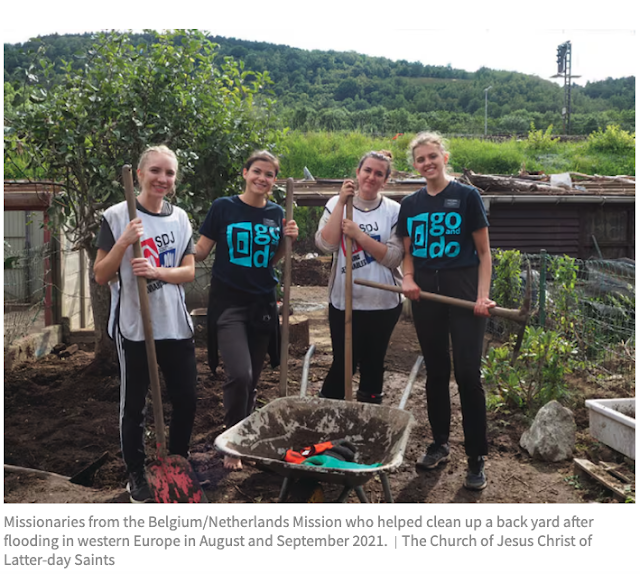How corporations and faith-based organizations partner with government to provide disaster relief
Public-private partnerships (PPPs) are crucial in disaster response, leveraging the strengths of both the private sector and public agencies to enhance the effectiveness and reach of humanitarian efforts. The examples of Walmart and the LDS Church illustrate how these partnerships function in practice, showcasing how collaboration between private entities, faith-based organizations, and government agencies can significantly improve disaster preparedness, response, and recovery.
Walmart’s Public-Private Partnership in Disaster Relief
Walmart has established itself as a key player in disaster response through its proactive and well-coordinated efforts during crises. The company’s supply chain management expertise, vast logistics network, and commitment to community welfare have made it an indispensable partner during emergencies.
Walmart's involvement in disaster relief highlights the agility and resourcefulness that a private corporation can bring to crisis situations. The nature of Walmart's partnership with public agencies, such as FEMA, is rooted in the company's logistical capabilities and its ability to mobilize resources rapidly. During disasters like Hurricane Katrina and Hurricane Maria, Walmart leveraged its supply chain management expertise and extensive logistics network to deliver essential goods to affected communities quickly.
The partnership between Walmart and government agencies is characterized by complementary roles: while public agencies coordinate large-scale disaster response and provide strategic oversight, Walmart uses its operational efficiency to fill gaps in logistics and ensure the timely delivery of supplies. This collaboration exemplifies how the private sector's agility and preparedness can enhance the overall disaster response, making it more effective and responsive to immediate needs.
Walmart’s Role in Disaster Relief
Walmart has established itself as a key player in disaster response through its proactive and well-coordinated efforts during crises. The company’s supply chain management expertise, vast logistics network, and commitment to community welfare have made it an indispensable partner during emergencies.
Hurricane Katrina Response: One of the most significant examples of Walmart's role in disaster relief is its response to Hurricane Katrina in 2005. While government agencies struggled with logistics, Walmart quickly mobilized its resources to deliver essential supplies such as water, food, and medicine to affected areas. The company had pre-existing disaster response plans, which allowed it to restore operations in its stores quickly, providing much-needed goods to communities in the storm's aftermath. Walmart also donated over $20 million in cash and merchandise to aid recovery efforts. This response highlighted how private sector agility and preparedness can complement government efforts in disaster scenarios.
Hurricane Maria Response: Walmart also played a crucial role during Hurricane Maria in 2017, which devastated Puerto Rico. The company worked closely with FEMA and other agencies to provide supplies, including food, water, and emergency items, to those in need. Walmart’s extensive logistics network enabled the rapid distribution of goods to areas that were otherwise hard to reach due to damaged infrastructure. This partnership between Walmart and government agencies underscored the importance of public-private collaboration in ensuring that resources reach affected populations swiftly.
The LDS Church’s Public-Private Partnership in Humanitarian Response
The LDS Church’s approach to disaster relief is rooted in its extensive humanitarian network and its commitment to service. The Church’s partnerships with government agencies, international NGOs, and other faith-based organizations enable it to provide swift and comprehensive assistance during disasters. The nature of this public-private partnership is based on the Church’s ability to mobilize volunteers, distribute pre-stocked emergency supplies, and coordinate efforts with other organizations to maximize the impact of its relief operations.
In the case of the Haiti earthquake and other ongoing disaster preparedness efforts, the LDS Church works closely with local governments and international bodies to ensure that aid reaches those most in need. The Church’s "Helping Hands" volunteers are often among the first to respond, demonstrating the effectiveness of faith-based organizations in complementing public sector initiatives. This partnership is characterized by mutual support, where the Church provides on-the-ground assistance and resources, while public agencies offer strategic coordination and broader support.
Haiti Earthquake Response: Following the catastrophic earthquake in Haiti in 2010, the LDS Church quickly mobilized its resources to assist in the relief efforts. The Church coordinated with local governments, international NGOs, and other faith-based organizations to provide food, water, medical supplies, and temporary shelter to the affected population. LDS volunteers, known as "Helping Hands," worked tirelessly on the ground to distribute supplies and assist in the rebuilding process. The Church's ability to quickly deploy resources and personnel demonstrated the effectiveness of faith-based public-private partnerships in responding to large-scale disasters.
Ongoing Disaster Preparedness and Response: The LDS Church operates an extensive network of welfare services, including food production, storage, and distribution facilities, which are strategically located to respond to emergencies. These facilities are stocked with non-perishable food, clothing, and hygiene kits, which can be rapidly deployed to disaster zones. The Church's long-standing partnerships with government agencies and other humanitarian organizations enhance its ability to provide immediate and sustained assistance in disaster-stricken areas. For instance, during natural disasters such as hurricanes, floods, and wildfires in the United States, the LDS Church has consistently been one of the first organizations to respond, working alongside FEMA and local governments to meet the needs of affected communities.
Conclusion
The public-private partnerships exemplified by Walmart and the LDS Church demonstrate the power of collaboration in disaster response. Walmart's operational efficiency and the LDS Church’s humanitarian reach complement government efforts, creating a more resilient and responsive disaster management system. These partnerships not only ensure immediate relief but also contribute to long-term recovery and community resilience, highlighting the critical role that private sector and faith-based organizations play alongside public agencies in safeguarding society against future crises.
Sources:
Media Information: Wal-Mart's response to Hurricane Katrina (walmart.com)
Church Welfare and Self-Reliance by the numbers – Church News (thechurchnews.com)

No comments:
Post a Comment